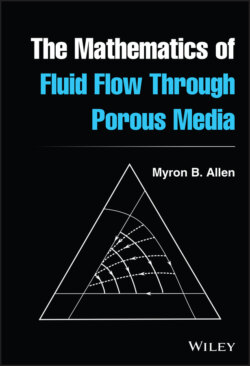Читать книгу The Mathematics of Fluid Flow Through Porous Media - Myron B. Allen III - Страница 11
1 Introduction 1.1 Historical Setting
ОглавлениеThe mathematical theory of fluid flows in porous media has a distinguished history. Most of this theory ultimately rests on Henry Darcy's 1856 engineering study [43], summarized in Section 3.1, of the water supplies in Dijon, France. A year after the publication of this meticulous and seminal work, Jules Dupuit [49], a giant among early groundwater scientists, recognized that Darcy's findings implied a differential equation. This observation proved to be crucial. For the next 75 years or so, the subject grew to encompass problems in multiple space dimensions—hence partial differential equations (PDEs)—with major contributions emerging mainly from the groundwater hydrology community. Pioneers included Joseph Boussinesq [25, 26], Philipp Forchheimer [53, 54], Charles S. Slichter [136], Edgar Buckingham [30], and Lorenzo A. Richards [129].
Interest in the mathematics of porous‐medium flows blossomed as oil production increased in economic importance during the early twentieth century. Prominent in the early petroleum engineering literature in this area are works by P.G. Nutting [110], Morris Muskat and his collaborators [104–107, 159, 160], and Miles C. Leverett and his collaborators [29, 95–97]. Between 1930 and 1960, mathematicians, groundwater hydrologists, petroleum engineers, and geoscientists made tremendous progress in understanding the PDEs that govern underground fluid flows.
Today, mathematical models of porous‐medium flow encompass linear and nonlinear PDEs of all major types, as well as systems involving PDEs having different types. The analysis of these equations and their numerical approximations requires an increasing level of mathematical and computational sophistication, and the models themselves have become essential design tools in the management of underground fluid resources.
From a philosophical perspective, credit for these advances belongs to scientists and engineers who clung tenaciously—often in the face of skepticism on the part of more “practically” oriented colleagues—to two premises. The first is that the key to effective modeling resides in careful mathematical reasoning. While this premise seems platitudinous, at any moment in history some practitioners believe that their science is too inherently messy to justify fastidious mathematics. On the contrary, the need for painstaking logical inferences from premises and hypotheses is arguably never greater than when the data are complicated, confusing, or hard to obtain.
The second premise is more subtle: In the absence of good data, sound mathematical models are essential. Far from outstripping the data, mathematical models tell us what data we really need. Moreover, they tell us what qualitative properties we can expect in predictions arising from a given input data set. They also reveal how properties of the data, such as its spatial variability and uncertainty, affect the models' predictive capabilities. If the required data cannot in principle be acquired, if the qualitative properties of the model conflict with the empirical evidence, or if the model cannot, in principle, provide stable predictions in the face of heterogeneity and uncertainty, then we must admit that our understanding is incomplete.
